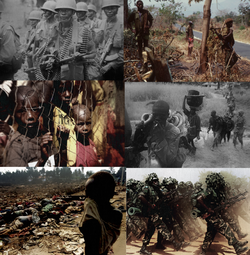User:Luziyca/Sandbox2: Difference between revisions
mNo edit summary |
mNo edit summary |
||
| Line 4: | Line 4: | ||
| width = | | width = | ||
| partof = | | partof = | ||
| image = [[File: | | image = [[File:Nasani-Rwizikuran War.png|250px]] | ||
| caption = | | caption = | ||
| date = 6<sup>th</sup> October, 1968 - 25<sup>th</sup> March, 1969<br>{{Age in years, months, weeks and days|month1=10|day1=6|year1=1968|month2=3|day2=25|year2=1969}} | | date = 6<sup>th</sup> October, 1968 - 25<sup>th</sup> March, 1969<br>{{Age in years, months, weeks and days|month1=10|day1=6|year1=1968|month2=3|day2=25|year2=1969}} | ||
| place = {{flag|Nasana}}<br>{{flag|Rwizikuru}} | | place = {{flag|Nasana}}<br>{{flag|Rwizikuru}} | ||
Revision as of 19:21, 6 August 2019
| Nasani-Rwizikuran War | |||||||||
|---|---|---|---|---|---|---|---|---|---|
 | |||||||||
| |||||||||
| Belligerents | |||||||||
| File:RwizikuruFlag.PNG Rwizikuru |
| ||||||||
| Commanders and leaders | |||||||||
|
File:RwizikuruFlag.PNG Izibongo Ngonidzashe File:RwizikuruFlag.PNG Fred Ngonidzashe File:RwizikuruFlag.PNG Munyaradzi Mhlanga † File:RwizikuruFlag.PNG Nokutendaishe Dulini File:RwizikuruFlag.PNG Jean-Marie Mombeshora |
| ||||||||
| Strength | |||||||||
| File:RwizikuruFlag.PNG Rwizikuru TBD soldiers |
| ||||||||
| Casualties and losses | |||||||||
| TBD soldiers |
Nasana 32,000 killed 10,000 wounded 4,000 missing and captured | ||||||||
|
TBD Rwizikuran civilians killed 300,000 Nasani civilians killed ton of internally displaced persons and refugees | |||||||||
The Nasani-Rwizikuran War (weRwizi: Hondo pakati peNasana naRwizikuru, Wopoto: ǃhoǂnha ri Olo'ǂnga خهوچنها ری ولوچنگا, Liberation of Olonga) was a war in Bahia that lasted from 1968 until 1969, over the territory of Yekumavirira which had been under the control of Rwizikuru, that started when Nasana attacked Rwizikuru. At the end of the war, the Purple Line was established along the front lines, and a population exchange took place.
Background
Origins
The area in question, Yekumavirira, had been part of the Wopoto Empire prior to its collapse in 1701. Following the collapse of the area, the expanding veRwizi tribes took control of the area. While they initially tried to coerce people to adopt their traditional religion, by the mid-1750s, the weRwizi converted to the Nasani school of Irfan under the rule of Chief Nyashadzashe Olonga, and thus resulted in the establishment of the Olonga Sultanate.
The Olonga Sultanate lasted until 1853, when Gaullica took the area over, and began instituting policies to promote the Solarian Catholic Church over the Irfanic population. As well, the Gaullicans instituted policies which cracked down on both the Wopoto language and the weRwizi language in favor of Gaullican. Over the next century, Gaullican rule became more influential over the region, but in 1936, with the end of the Great War, Gaullica was forced to give their colony in Yekumavirira to the Estmerish. The Estmerish placed what they deemed "Olongaland" under the jurisdiction of the colony in Rizikuru, and made it a district of the colony, and expelled many of the Gaullicans residing in the territory.
Rwizikuran rule and growing tensions
In 1946, Rwizikuru was granted independence following tensions between the Estmerish colonial authorities and the Rwizikuran National Movement led by Shungudzemwoyo Nhema and Izibongo Ngonidzashe. This included Olongaland, which was quickly renamed back to Yekumavirira by the newly independent government.
Under Samhuri Ngonidzashe's rule from 1946 to 1954, he began instituting policies to "create a consolidated nation-state." To this end, Samhuri Ngonidzashe ordered all schools across Rwizikuru to use the weRwizi language, and to reduce the use of Estmerish in schools in 1948.
This policy was unpopular among the Wopoto people living in Yekumavirira, as they were angered that schools in their communities, which had hiherto been primarily taught in Estmerish and in the Wopoto language would be forced to teach their children "the language of their enemies."
Nasana
After the Third Nasani War, ethno-religious suppression and relocation took place across the country, under making provisions for a secure and unified Irfanic nation. Many Nasani groups underwent villagization in re-education work camps. Since 1953 when the Third Nasani War ended, Sotirians took a pilgrimage to Euclea and mostly Yekumavirira, where they could worship freely and find new lands.
For a time the Nasani government endorsed this and even funded the migration against the opposition of their neighbors. This was known as the Great Nasanic Exodus, as over 500,000 Sotirians fled Nasana and escaped government villages from 1953 to 1959. Still, many Sotirians were left in Nasana, practicing their religion in secret while imitating Irfanic practice.
The Great Nasanic Exodus heightened tensions in Yekumavirira, as old Irfanic and Sotirian communities began to feud over land. It is suggested the exodus of Sotirians to Yekumavirira was a fabrication and government document leaks affirm this theory, though this not officially endorsed. This would heightened tensions and later justify Nasanai Invasion as a means to protect Irfanic communities from increasing violence.
Events
(TBD)
Aftermath
(TBD)
Impact
One of the greatest impacts of the war was the expulsion of Rwizikuran Irfanic people to Nasana, and the expulsion of Nasani Sotirians to Rwizikuru as part of the Treaty of TBD which ended the war between the two countries. As this made no distinctions along ethnic lines, weRwizi who followed the Irfanic faith and who had known no other country, and Sortirian Wopoto found themselves in unfamiliar territories.
Diplomatically, relations have remained frosty between the two sides since the war... (TBC)